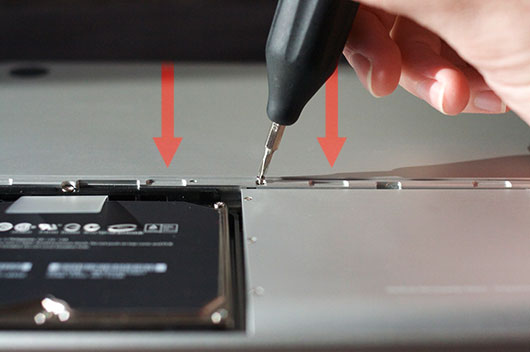To access the RAM slots in a unibody MacBook you must first remove the back plate—a thin piece of aluminum attached by eight tiny screws. Half of the screws are hidden beneath the battery cover, and each one is surrounded by a recessed magnetic zone. The purpose of these zones is ostensibly to help keep the battery cover seamlessly attached to the case.

But removing the screws made it clear that the magnetic zones serve a second function. When my screwdriver slipped, the screw didn’t fall into the depths of the case. Instead, it flew right over to the magnet, and I was spared the pain of extracting a three-millimeter needle from an expensive electronic haystack.
It’s a perfect example of real-life defensive design: anticipate where your customers might slip up and try your best to keep them from doing it. Have you encountered any good defensive design lately?

wesley
on 20 Nov 08Seems to me that is an accidental benefit, not something they designed for.
CJ Curtis
on 20 Nov 08pretty slick…probably inspired by magnetic tipped screwdrivers, which are also incredibly useful.
another great product is one of Motorola’s lines of Bluetooth earpieces, which includes a small charging stand that also attaches with magnets. Just get it in the general vicinity and it smacks into place.
Justin
on 20 Nov 08I was recently impressed with SitePoint’s site. I input my Yahoo email address do download one of their ebooks. After submitting the form, they informed me that Yahoo addresses often experience a long delay before receiving their emails, and they gave me a chance to use an alternate address. I think this was a good example of defensive design on their part, and definitely impressed me.
andy
on 20 Nov 08I drive an old Volvo 240. One of the features that I absolutely love is that the lights turn off with the car. No more dead batteries due to lights being left on. No need to listen to some annoying bell going off when I open the door either.
Colin`
on 20 Nov 08My wife drives an old Volvo too. Recently I had to work on the car and it has a build-in display of the computer’s error codes. No need to go out and a buy a $100 gadget to get the code!
Morley
on 20 Nov 08One could argue that a better defensive design is to use only one screw, or better yet, use no screws.
Ryan Britton
on 20 Nov 08I do not have this particular model, but on previous models of the 17”, there are three screws on the backside of the button to release the lid. These must be removed to open the case. The magnets that pull the recessed latches out from the lid make it very difficult to get the screws back in because they keep wanting to jump from the screwdriver to the magnet. Is that a problem here?
Patrick D
on 20 Nov 08Is the battery cover aluminum? I wouldn’t think it would stick to the magnets too well…
@andy: I used to love that about my Volvo. It makes so much sense. I also loved that it was almost physically impossible to lock your keys inside the car. (The lock won’t go down when the driver’s door is open, so the only way to lock it is by using the key from the outside.)
Benjamin Edgar
on 20 Nov 08@Patrick D: yeah, i dont think the magnets keep the cover in place as its aluminum which wouldn’t interact with the magnets right?
Also – does anyone else find the aluminum battery cover to be super flimsy? All the bragging about the unibody strength and this flimsy little aluminum cover…...doesn’t match. And it rattles! Still a great laptop though.
--Josh
on 20 Nov 08I just upgraded the RAM in my new MacBook Pro this morning, and was checking out these magnetic plates. They sure do a great job of catching the screw when they slip.
Joe S
on 21 Nov 08The aerospace industry, especially military aircraft, is covered with defensive designs everywhere. However, most of it takes a degree or two in aerospace design and/or a military background to pick up on it. But its there. And its pretty impressive.
Emir
on 21 Nov 08Every time I fill the gas in the car:
The gas tank cap is mechanically attached to the car. you can never loose it by leaving it on top of the car.
Stefano
on 21 Nov 08Last week my toddler has quietly removed (and hidden) the power button from my desktop case. Isn’t it defensive post design ?
V
on 21 Nov 08This is an overkill
Niels
on 21 Nov 08Joe: Do you have any examples re defensive design in the (military) aerospace industry? Would be great to hear a little more about it!
IainW
on 22 Nov 08For anyone who’s interested, here’s a podcast of the BBC’s Radio 4 Material World programme discussing defensive design applied to deterring theft…
http://www.bbc.co.uk/radio4/science/thematerialworld_20081002.shtml
Steve C
on 23 Nov 08In my dell I have to unscrew one (reasonably) sized screw :o
This discussion is closed.